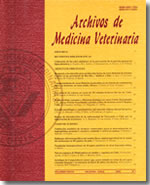Abortigenic diseases in dairy farms in the Ñuble Province: prevalence and spatial analysis
Main Article Content
Abstract
The bovine abortion syndrome is a multicausal problem, the objetives of this study were to provide information on the magnitude of the seroprevalence of four abortigenic agents and their association with some management practices the farms. A cross-sectional study was performed using 40 farms and 400 dairy cows which were statistically estimated based on a two-stage sampling. Information about management of the dairy farms was collected using a personal questionnaire, to estimate the prevalence of diseases causing abortion in the province of Ñuble, Bio-Bio Disctrict. Blood samples were taken to estimate the seroprevalence of brucelosis, bovine viral diarrhea virus, neosporosis and leptospirosis. Farm-level prevalence for the pathogens analysed was highest for BVD (97.5%), followed by neosporosis (87.4%) and leptospirosis (52.1%), the same trend but at a lower level was found at individual level, being the highest proportion for BVD (62.1%), Neosporosis (22.4%) and leptospirosis. (12.2%). The animal prevalence of DVB and farm prevalence of neosporosis significantly increased in larger herds, Brucelosis seropositivity was not found. Factors related to seroprevalence for each pathogen, are related to biosafety and degree of intensiveness of the production, despite the control measures adopted.

